Properly packing and organizing your camping backpack is crucial for a comfortable and efficient outdoor adventure. In this guide, I will provide you with expert tips and techniques to help you pack your camping backpack efficiently. I will cover the different aspects of packing, including finding the right size backpack, organizing your gear for optimal weight distribution, and packing methods to ensure easy access to essential items. By following these guidelines, you can enjoy a hassle-free and enjoyable camping experience.
Key Takeaways:
- Choosing the right size backpack is crucial for a well-organized camping trip.
- Proper weight distribution helps maintain balance and reduce strain on your body.
- Packing your backpack in sections and utilizing pockets and straps allows for easy access to essential items.
- Compression sacks and rain covers are useful tools to maximize space and protect your gear.
- Investing in lightweight camping gear can significantly reduce the overall weight of your backpack.
Choosing the Right Size Backpack
Before you start packing, it’s important to choose the right size backpack for your adventure. The size of your backpack will depend on the duration of your trip and the amount of gear you need to carry.
For day hikes, a 20-30 liter backpack is usually sufficient. Weekenders may require a 40-50 liter pack, while multi-day backpacking trips may require a 50-75 liter backpack. Expeditions and long treks may require a backpack with a capacity of 75-110+ liters.
It’s essential to ensure that your backpack fits properly and distributes weight evenly to prevent discomfort and strain on your body.
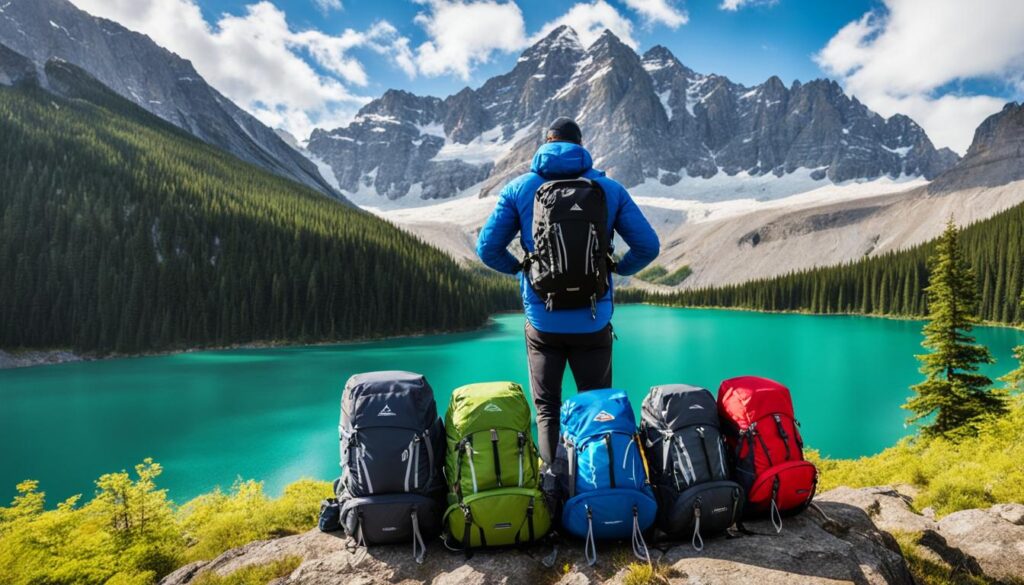
Organizing Your Backpack for Weight Distribution
Proper weight distribution is crucial when organizing your backpack for a comfortable and balanced outdoor experience. By placing heavy items close to your back and centered around your mid-back, you can maintain balance and minimize strain on your body. This strategic positioning helps keep your center of gravity closer to its normal location, reducing the risk of injuries and ensuring stability while hiking.
Lighter items should be placed further away from your back to maintain the proper weight distribution. By following this principle, you can distribute the load evenly and prevent unnecessary discomfort on your journey.
Another important consideration for efficient backpack organization is the use of lightweight camping gear. Investing in lightweight equipment can significantly reduce the overall weight of your backpack, making it easier to carry for extended periods. By opting for lightweight alternatives without compromising on quality and durability, you can maximize comfort during your outdoor adventures.
Remember, a properly organized backpack with the right weight distribution is essential for a smooth and enjoyable camping experience. Incorporate these tips into your packing routine to ensure a well-balanced load and minimize strain on your body while exploring the great outdoors.
Benefits of Proper Weight Distribution
Proper weight distribution in your backpack offers several benefits:
- Improved balance and stability during hiking
- Reduced strain on your body, minimizing the risk of injuries
- Enhanced comfort during long-distance treks
- Efficient use of energy, allowing you to enjoy your camping experience to the fullest
By organizing your backpack for optimal weight distribution and investing in lightweight camping gear, you can set yourself up for a successful and enjoyable outdoor adventure. Remember, a well-organized backpack not only ensures your comfort but also allows you to access your essentials with ease when you need them the most.
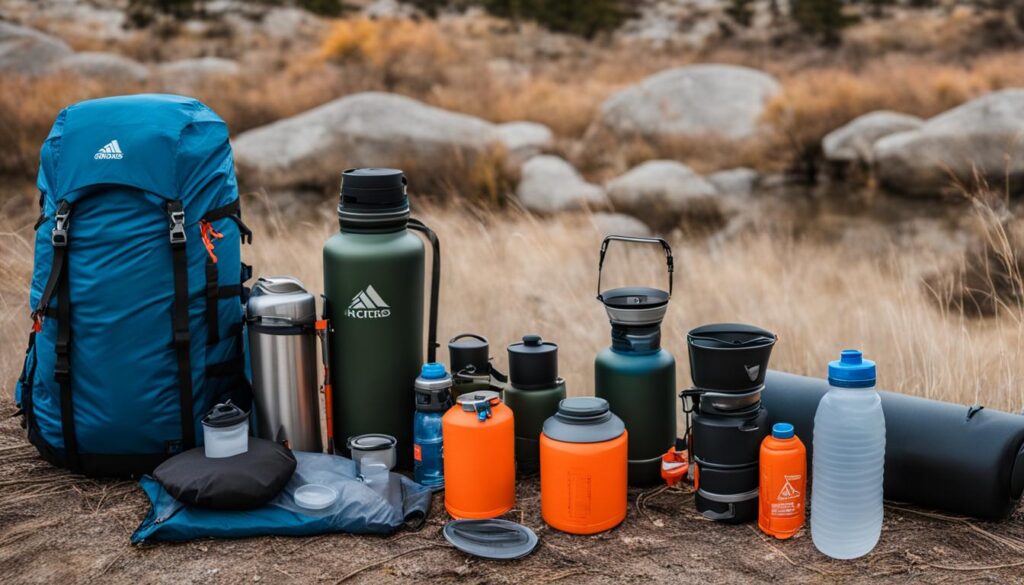
Packing Methods for Easy Access
When it comes to packing your camping backpack, it’s important to prioritize easy access to your essential items. By following these packing methods, you can ensure that everything you need is within reach, saving you time and effort during your outdoor adventure.
Lay Out and Assess Your Gear
Before you start packing, lay out all your gear and assess what you truly need for your camping trip. This step helps you eliminate any unnecessary items, reducing the weight and clutter in your backpack. Consider the duration and location of your trip, as well as the weather conditions, when deciding what to bring.
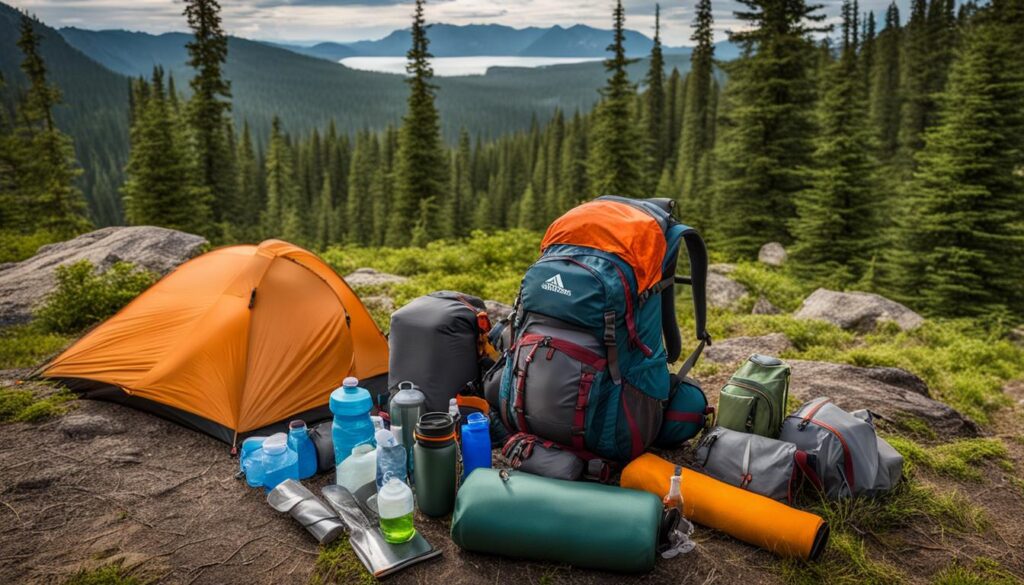
Pack in Three Parts
Divide your backpack into three sections – bottom, middle, and top – for efficient organization. Each section serves a specific purpose and ensures that your gear is balanced and easy to access when needed.
| Section | Items to Pack |
|---|---|
| Bottom |
|
| Middle |
|
| Top |
|
Utilize Pockets and Straps
Take advantage of the pockets and straps on your backpack to store smaller items that you need easy access to. Keep your map, compass, and other navigation tools in a dedicated pocket for quick reference. Use the side pockets for water bottles or a small umbrella. Utilize the straps to attach items like trekking poles or a sleeping pad.
Remember, the key to easy access is thoughtful organization. By packing your backpack strategically, you can avoid rummaging through your gear and locate everything you need with ease.
Following these packing methods will help you save time and effort when accessing your essentials during your camping trip. A well-organized backpack ensures that you can focus on enjoying the great outdoors without any unnecessary hassle.
Using Compression Sacks and Rain Covers
When it comes to efficient camping backpack organization, compression sacks and rain covers are essential tools to consider. These items not only help save space but also protect your gear from unexpected weather conditions.
Compression Sacks: Maximizing Space
Compression sacks are designed to remove excess air from your packed items, allowing you to pack more efficiently and save space in your backpack. By compressing your gear, you can fit more essential items into your backpack without sacrificing organization.
Organize your gear by type and use compression sacks to keep everything compact and in order. For example, pack your clothing in one compression sack, your sleeping bag in another, and so on. This will make it easier to locate items when you need them, saving you valuable time and effort during your camping adventure.
However, it’s important to note that you should avoid storing your sleeping bag in a compressed state for extended periods. Continuous compression can affect its insulation properties over time. To maintain the quality and warmth of your sleeping bag, remove it from the compression sack and allow it to loft when not in use.
Rain Covers: Protecting Your Gear
Another crucial item to include in your camping backpack essentials is a rain cover. Weather conditions can be unpredictable, and sudden rain showers can put your gear at risk of getting soaked.
A rain cover is a waterproof covering specifically designed to protect your backpack and gear from water damage. It acts as a shield, preventing rainwater from seeping into your bag and soaking your belongings. By using a rain cover, you can ensure that your gear stays dry and maintain optimal comfort even during wet weather conditions.
When choosing a rain cover, make sure it fits your backpack properly and securely. Look for one that offers full coverage and features adjustable straps or cords to ensure a snug fit. Additionally, opt for a rain cover made from durable and waterproof materials to guarantee maximum protection.
Remember, by using compression sacks and rain covers, you can optimize the space in your backpack and protect your gear from unexpected weather conditions. These simple yet effective tools can make a significant difference in your camping experience, providing convenience and peace of mind.
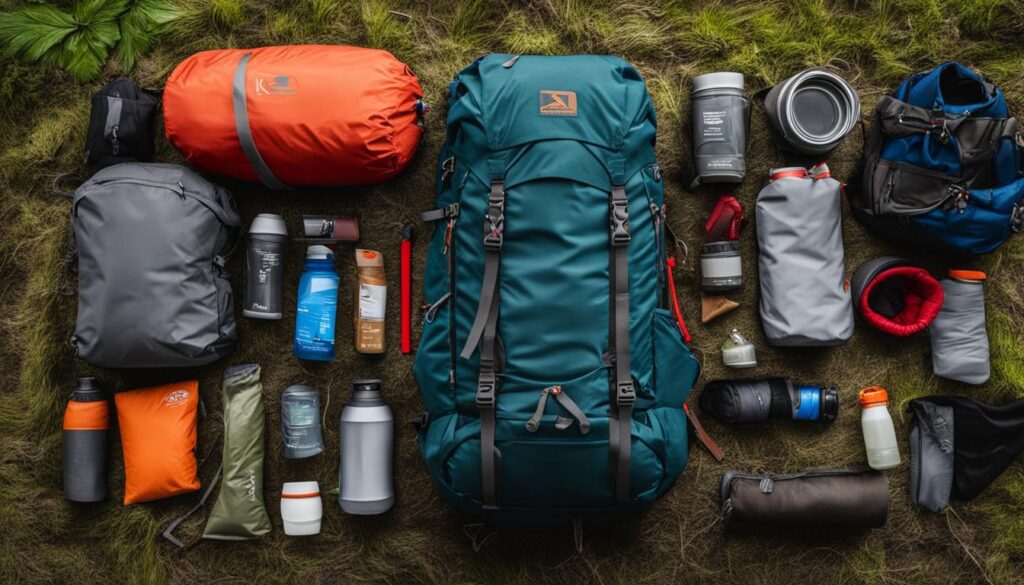
| Benefits of Compression Sacks | Benefits of Rain Covers |
|---|---|
| Maximizes space in your backpack | Protects your backpack and gear from rain |
| Allows for efficient gear organization | Prevents water damage to essential items |
| Easy access to compressed items | Maintains optimal comfort during wet weather |
| Protects sleeping bag insulation properties | Reduces the need for costly gear replacements |
Additional Tips for Efficient Packing
Alongside the packing techniques we’ve already discussed, here are some additional tips to help you maximize the efficiency of your camping backpack organization:
- Pack multi-purpose items: Opt for gear and clothing that serves multiple functions to save space and reduce weight. For example, choose a versatile jacket that can be worn in different weather conditions or a lightweight camp stove that can also be used as a pot stand.
- Use packing cubes: Invest in packing cubes or small bags to categorize and compartmentalize your gear. This makes it easier to locate specific items and maintain organization throughout your trip.
- Roll your clothes: Instead of folding your clothes, roll them tightly to maximize space in your backpack. This not only saves room but also helps prevent wrinkles.
- Utilize outer pockets: Take advantage of the outer pockets on your backpack to store frequently accessed items, such as water bottles, snacks, or a compass. This way, you won’t have to dig through the main compartment every time you need something.
- Consider a daypack: If you plan to embark on day hikes or explore surrounding areas without your main backpack, pack a smaller daypack. This allows you to leave unnecessary items at the campsite while still having essentials readily available.
By incorporating these packing hacks and tips into your camping backpack packing routine, you can ensure a well-organized and efficient outdoor adventure.
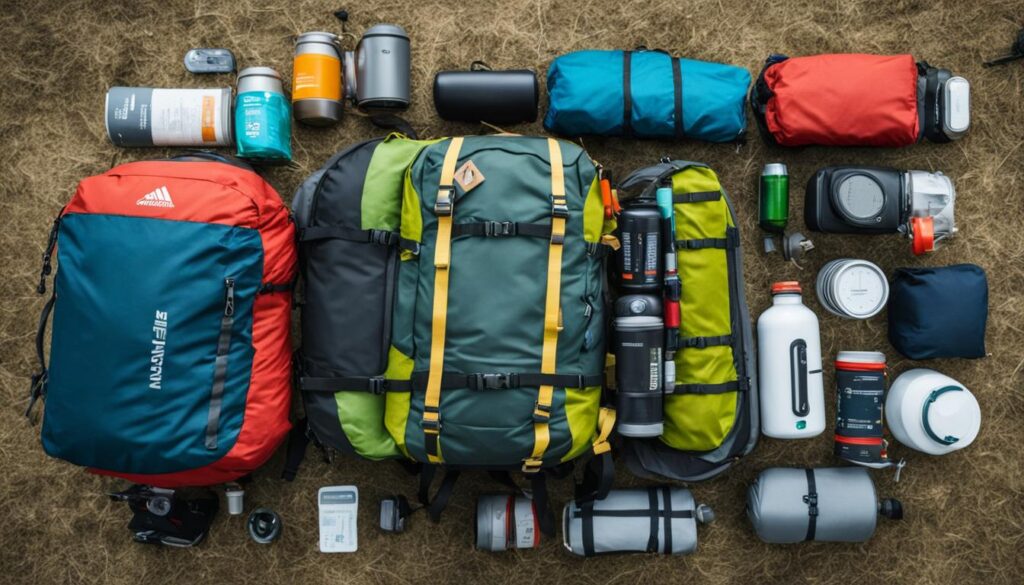
Enjoy a Hassle-free Camping Experience
Ready to embark on your camping adventure? By following these expert tips and techniques, you can pack your camping backpack efficiently and ensure a hassle-free experience. It all starts with choosing the right size backpack. Selecting a pack that suits the duration of your trip and the amount of gear you need is essential for optimal comfort and functionality.
Once you have your backpack, organize your gear for weight distribution. Place heavier items closer to your back and centered around your mid-back, while lighter items should be positioned further away. This strategic distribution helps maintain balance, reduces strain on your body, and enhances stability on the trail.
When it comes to packing methods, consider the three-part approach: bottom, middle, and top. Pack your lightweight gear, like a sleeping bag and night-time clothes, at the bottom. Place heavier items, such as food, cooking equipment, and a hydration bladder in the middle section, positioned close to your back. Lastly, keep frequently accessed items like snacks, a jacket, and a headlamp at the top for easy access. Utilize the pockets and straps on your backpack to store smaller essentials that you need to reach quickly.
To further optimize your packing, invest in lightweight camping gear. Minimizing the overall weight of your backpack will enhance your comfort and endurance on the trail. Consider compression sacks to compactly organize your gear by type and save valuable space. However, it’s important not to store your sleeping bag in a compressed state for long periods, as it can impact its insulation properties. Additionally, use a rain cover to protect your backpack and gear from water damage in case of rain.
By implementing these efficient camping backpack organization techniques and incorporating the right gear into your backpacking checklist, you’ll be well-prepared for an enjoyable camping experience. Pack smart, stay organized, and savor every moment of your outdoor adventure.
FAQ
How do I choose the right size backpack for camping?
The size of your backpack will depend on the duration of your trip and the amount of gear you need to carry. For day hikes, a 20-30 liter backpack is usually sufficient. Weekenders may require a 40-50 liter pack, while multi-day backpacking trips may require a 50-75 liter backpack. Expeditions and long treks may require a backpack with a capacity of 75-110+ liters. It’s important to ensure that your backpack fits properly and distributes weight evenly to prevent discomfort and strain on your body.
How do I organize my camping backpack for optimal weight distribution?
To properly distribute weight, place heavy items close to your back and centered around your mid-back. This helps maintain balance and minimizes strain on your body. Lighter items should be placed further away. Additionally, consider investing in lightweight camping gear to minimize the overall weight of your backpack.
What packing methods can I use for easy access to essential items?
Start by laying out all your gear and packing your backpack in three sections: bottom, middle, and top. Pack lightweight gear like a sleeping bag in the bottom section. Place heavier items like food, cooking equipment, and a hydration bladder in the middle section, close to your back for weight distribution. Keep frequently accessed items like snacks, a jacket, and a headlamp at the top for convenience. Utilize pockets and straps on your backpack for smaller items that require easy access.
How can compression sacks and rain covers help with efficient packing?
Compression sacks remove excess air, allowing you to pack more efficiently and save space in your backpack. Use compression sacks to organize your gear by type and keep it compact. However, avoid storing your sleeping bag in a compressed state for long periods. Consider using a rain cover to protect your backpack and gear from water damage in case of rain, ensuring your belongings stay dry and comfortable.
What are some additional tips for efficient packing?
Some additional tips include assessing what gear is necessary and eliminating any unnecessary items before packing, investing in lightweight camping gear to reduce overall weight, and utilizing pockets and straps on your backpack for easy access to smaller items. Consider using a rain cover to protect your gear from water damage. Properly organizing and packing your backpack will make your camping experience more enjoyable and hassle-free.
How can I enjoy a hassle-free camping experience?
By choosing the right size backpack, organizing your gear for weight distribution, utilizing packing methods for easy access, and investing in compression sacks and rain covers, you can pack your camping backpack efficiently and enjoy a hassle-free camping experience. Additionally, consider utilizing lightweight camping gear and following the tips mentioned above to ensure comfort and convenience during your outdoor adventure.

